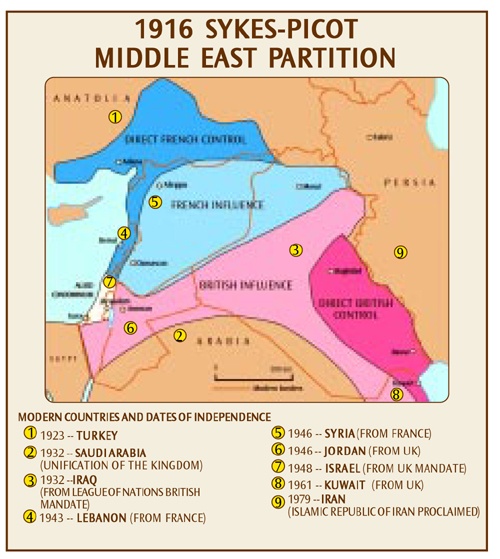The convenient scapegoat of the Sykes-Picot Agreement
Dr. Azeem Ibrahim/Al Arabiya/May 22/16
One of the favorite tropes in the Middle East about why the region is so politically unstable is to blame the Sykes-Picot Agreement signed exactly 100 years ago, in which Britain and France settled on how they would partition the territory of the Ottoman Empire after their eventual defeat in WW1. Sykes-Picot is alleged to be the reason why between Syria, Iraq, Jordan and Saudi Arabia there exist straight-line borders. Even though these borders clearly do not map at all well to local demographic realities, as when, for example, local tribes in the borderlands between Iraq and Saudi Arabia, or Iraq and Syria would have owned lands on both sides of the border and would have moved freely between these lands.
The theory is that by drawing up these “unnatural” borders, for their own imperial and administrative purposes and with complete lack of interests for the local populations, the colonial powers set up the stage for the unstable internal politics in all these countries, and, consequently, the volatility of the region. A somewhat inconvenient fact to this theory is that the respective delineation of the spheres of French and British influence in the Sykes-Picot Agreement, and the eventual borders of Iraq, Syria, Lebanon and Jordan when they gained independence after WW2, do not correspond.
But leaving that aside, the Arabs in the region have the right to be aggrieved at the Agreement, because it rescinded on all the territorial promises Britain had made to encourage them to join forces against the Ottomans. The problem is what to do with such a grievance. Sykes-Picot is the perfect scapegoat, used over the years by political leaders to justify and excuse their own mismanagement and corruption
In the Middle East, Sykes-Picot has come to represent two things:
1) the ultimate example of Western colonial meddling for which all the region’s economic and political impediments today can be blamed; and for peddlers of radical Islamism, 2) the ultimate assault of Western Crusaders and Zionists against Islam, because it paved the way to Britain establishing the Mandate of Palestine which they would eventually grant for the establishment of the State of Israel.
But again, there are some pesky facts in the way of this neat theory. Unlike in Africa, where countries and local populations have every right to rile against the legacy of Western colonialism and its abhorrent history of slavery and exploitation, the Arab world has, throughout this period, been dominated not by “foreign”, Western empires, but rather by the Muslim Ottoman Empire.
The Ottoman Empire
And throughout this period, the Ottoman Empire was also the de jure and de facto Islamic Caliphate. The three decades of Western, League of Nations mandated administration, saw minimal asset stripping in the region, and substantial investment, especially in infrastructure, education and, inevitably, the oil extraction industry. Assets which have paved the way for prosperity for these countries for decades after they have gained independence.
Those assets were not squandered by Western Crusaders and Zionists. The reason why the public administration in these countries has decayed to braking-point over the recent decades, why the economies have stagnated, why the repressive regimes of Saddam Hussain and the al-Assad family have come to dominate the region, and went on to wage war against their neighbors in Iran, Kuwait and Israel, have next to nothing to do with Sykes-Picot.
The fundamental problem is that the people of these countries have failed to keep their political leaders accountable, and to demand that they be governed and administered effectively and fairly. And Sykes-Picot is the perfect scapegoat, used over the years by political leaders to justify and excuse their own mismanagement and corruption.
The situation in which the Middle East found itself in 1948 when the mandates gained independence was much better than the situation in which Europe found itself that year. These countries had reasonably well educated populations and ample natural resources, healthy infrastructure and public services.
By contrast, Europe lay in ruins – a victim of its own follies. The difference is that Europeans knew they had no one to blame for their situation but themselves. They dusted themselves off after WW2, foreswore stupid nationalism, and knuckled down to rebuild their lives, their societies, and their countries.
And in the Middle East? Everything that went well was because of how wonderful they were and everything that went badly was someone else’s fault. Specifically, Israel, America, Britain or France. The mess in the Middle East today is not a consequence of Sykes-Picot. It is a consequence of seven decades of Arabs refusing to assume responsibility for their own problems.
======================================================================================================================================================
The Sykes-Picot Agreement (1916)
Sources: Encyclopaedia Judaica.
The Sykes-Picot Agreement (officially the 1916 Asia Minor Agreement) was a secret agreement reached during World War I between the British and French governments pertaining to the partition of the Ottoman Empire among the Allied Powers. Russia was also privy to the discussions.
The Middle East per the Sykes-Picot Agreement.
The first round of discussions took place in London on November 23, 1915 with the French government represented by François-Georges Picot, a professional diplomat with extensive experience in the Levant, and the British delegation led by Sir Arthur Nicolson. The second round of discussions took place December 21 with the British now represented by Sir Mark Sykes, a leading expert on the East.
Having juxtaposed the desiderata of all the parties concerned – namely the British, the French and the Arabs – the two statesmen worked out a compromise solution. The terms of the partition agreement were specified in a letter dated May 9, 1916, which Paul Cambon, French ambassador in London, addressed to Sir Edward Grey, British foreign secretary. These terms were ratified in a return letter from Grey to Cambon on May 16 and the agreement became official in an exchange of notes among the three Allied Powers on April 26 and May 23, 1916.
According to the agreement, France was to exercise direct control over Cilicia, the coastal strip of Syria, Lebanon and the greater part of Galilee, up to the line stretching from north of Acre to the northwest corner of the Sea of Galilee (“Blue Zone”). Eastward, in the Syrian hinterland, an Arab state was to be created under French protection (“Area A”). Britain was to exercise control over southern Mesopotamia (“Red Zone”), as well as the territory around the Acre-Haifa bay in the Mediterranean with rights to build a railway from there to Baghdad. The territory east of the Jordan River and the Negev desert, south of the line stretching from Gaza to the Dead Sea, was allocated to an Arab state under British protection (“Area B”). South of France’s “blue zone,” in the area covering the Sanjak of Jerusalem and extending southwards toward the line running approximately from Gaza to the Dead Sea, was to be under international administration (“Brown Zone”).
In the years that followed, the Sykes-Picot Agreement became the target of bitter criticism both in France and in England. Lloyd George referred to it as an “egregious” and a “foolish” document. Zionist aspirations were also passed over and this lapse was severely criticized by William R. Hall, head of the Intelligence Department of the British Admiralty, who pointed out that the Jews have “a strong material, and a very strong political interest in the future of the country and that in the Brown area the question of Zionism… [ought] to be considered.”
Areas of Palestine per the agreement
The agreement was officially abrogated by the Allies at the San Remo Conference in April 1920, when the Mandate for Palestine was conferred upon Britain.
Text of Sykes-Picot Agreement
It is accordingly understood between the French and British governments:
That France and Great Britain are prepared to recognize and protect an independent Arab states or a confederation of Arab states (a) and (b) marked on the annexed map, under the suzerainty of an Arab chief. That in area (a) France, and in area (b) great Britain, shall have priority of right of enterprise and local loans. That in area (a) France, and in area (b) great Britain, shall alone supply advisers or foreign functionaries at the request of the Arab state or confederation of Arab states.
That in the blue area France, and in the red area great Britain, shall be allowed to establish such direct or indirect administration or control as they desire and as they may think fit to arrange with the Arab state or confederation of Arab states.
That in the brown area there shall be established an international administration, the form of which is to be decided upon after consultation with Russia, and subsequently in consultation with the other allies, and the representatives of the Shariff of Mecca.
That great Britain be accorded (1) the ports of Haifa and acre, (2) guarantee of a given supply of water from the Tigres and Euphrates in area (a) for area (b). His majesty’s government, on their part, undertake that they will at no time enter into negotiations for the cession of Cyprus to any third power without the previous consent of the French government.
That Alexandretta shall be a free port as regards the trade of the British empire, and that there shall be no discrimination in port charges or facilities as regards British shipping and British goods; that there shall be freedom of transit for British goods through Alexandretta and by railway through the blue area, or (b) area, or area (a); and there shall be no discrimination, direct or indirect, against British goods on any railway or against British goods or ships at any port serving the areas mentioned.
That Haifa shall be a free port as regards the trade of France, her dominions and protectorates, and there shall be no discrimination in port charges or facilities as regards French shipping and French goods. There shall be freedom of transit for French goods through Haifa and by the British railway through the brown area, whether those goods are intended for or originate in the blue area, area (a), or area (b), and there shall be no discrimination, direct or indirect, against french goods on any railway, or against french goods or ships at any port serving the areas mentioned.
That in area (a) the Baghdad railway shall not be extended southwards beyond Mosul, and in area (b) northwards beyond Samarra, until a railway connecting Baghdad and Aleppo via the Euphrates valley has been completed, and then only with the concurrence of the two governments.
That great Britain has the right to build, administer, and be sole owner of a railway connecting Haifa with area (b), and shall have a perpetual right to transport troops along such a line at all times. It is to be understood by both governments that this railway is to facilitate the connection of Baghdad with Haifa by rail, and it is further understood that, if the engineering difficulties and expense entailed by keeping this connecting line in the brown area only make the project unfeasible, that the french government shall be prepared to consider that the line in question may also traverse the Polgon Banias Keis Marib Salkhad tell Otsda Mesmie before reaching area (b).
For a period of twenty years the existing Turkish customs tariff shall remain in force throughout the whole of the blue and red areas, as well as in areas (a) and (b), and no increase in the rates of duty or conversions from ad valorem to specific rates shall be made except by agreement between the two powers.
There shall be no interior customs barriers between any of the above mentioned areas. The customs duties leviable on goods destined for the interior shall be collected at the port of entry and handed over to the administration of the area of destination.
It shall be agreed that the french government will at no time enter into any negotiations for the cession of their rights and will not cede such rights in the blue area to any third power, except the Arab state or confederation of Arab states, without the previous agreement of his majesty’s government, who, on their part, will give a similar undertaking to the french government regarding the red area.
The British and French government, as the protectors of the Arab state, shall agree that they will not themselves acquire and will not consent to a third power acquiring territorial possessions in the Arabian peninsula, nor consent to a third power installing a naval base either on the east coast, or on the islands, of the red sea. This, however, shall not prevent such adjustment of the Aden frontier as may be necessary in consequence of recent Turkish aggression.
The negotiations with the Arabs as to the boundaries of the Arab states shall be continued through the same channel as heretofore on behalf of the two powers.
It is agreed that measures to control the importation of arms into the Arab territories will be considered by the two governments.
I have further the honor to state that, in order to make the agreement complete, his majesty’s government are proposing to the Russian government to exchange notes analogous to those exchanged by the latter and your excellency’s government on the 26th April last. Copies of these notes will be communicated to your excellency as soon as exchanged. I would also venture to remind your excellency that the conclusion of the present agreement raises, for practical consideration, the question of claims of Italy to a share in any partition or rearrangement of turkey in Asia, as formulated in Article 9 of the agreement of the 26th April, 1915, between Italy and the allies.
His Majesty’s Government further consider that the Japanese government should be informed of the arrangements now concluded.
Sources:Encyclopaedia Judaica. © 2008 The Gale Group. All Rights Reserved.
The Avalon Project and Middle East Maps [the maps are not in the original document]
L. Stein, The Balfour Declaration (1961), 237–69, index; E. Kedourie, England and the Middle East (1956), 29–66, 102–41; J. Nevakivi, Britain, France and the Arab Middle East (1969), 35–44, index; C. Sykes, Two Studies in Virtue (1953), index; H.F. Frischwasser-Ra’ana, The Frontiers of a Nation (1955), 5–73; I. Friedman, The Question of Palestine, 1914 – 1918. British-Jewish-Arab Relations (1973, 19922), 97–118; idem, Palestine: A Twice Promised Land? The British, the Arabs and Zionism, 1915 – 1920 (2000), 47–60.





















